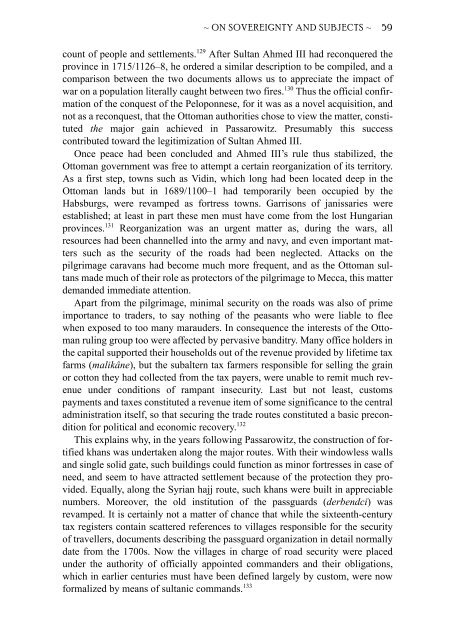The Ottoman Empire and the World Around It - Course Information
The Ottoman Empire and the World Around It - Course Information
The Ottoman Empire and the World Around It - Course Information
Create successful ePaper yourself
Turn your PDF publications into a flip-book with our unique Google optimized e-Paper software.
~ ON SOVEREIGNTY AND SUBJECTS ~ 59<br />
count of people <strong>and</strong> settlements. 129 After Sultan Ahmed III had reconquered <strong>the</strong><br />
province in 1715/1126–8, he ordered a similar description to be compiled, <strong>and</strong> a<br />
comparison between <strong>the</strong> two documents allows us to appreciate <strong>the</strong> impact of<br />
war on a population literally caught between two fires. 130 Thus <strong>the</strong> official confirmation<br />
of <strong>the</strong> conquest of <strong>the</strong> Peloponnese, for it was as a novel acquisition, <strong>and</strong><br />
not as a reconquest, that <strong>the</strong> <strong>Ottoman</strong> authorities chose to view <strong>the</strong> matter, constituted<br />
<strong>the</strong> major gain achieved in Passarowitz. Presumably this success<br />
contributed toward <strong>the</strong> legitimization of Sultan Ahmed III.<br />
Once peace had been concluded <strong>and</strong> Ahmed III’s rule thus stabilized, <strong>the</strong><br />
<strong>Ottoman</strong> government was free to attempt a certain reorganization of its territory.<br />
As a first step, towns such as Vidin, which long had been located deep in <strong>the</strong><br />
<strong>Ottoman</strong> l<strong>and</strong>s but in 1689/1100–1 had temporarily been occupied by <strong>the</strong><br />
Habsburgs, were revamped as fortress towns. Garrisons of janissaries were<br />
established; at least in part <strong>the</strong>se men must have come from <strong>the</strong> lost Hungarian<br />
provinces. 131 Reorganization was an urgent matter as, during <strong>the</strong> wars, all<br />
resources had been channelled into <strong>the</strong> army <strong>and</strong> navy, <strong>and</strong> even important matters<br />
such as <strong>the</strong> security of <strong>the</strong> roads had been neglected. Attacks on <strong>the</strong><br />
pilgrimage caravans had become much more frequent, <strong>and</strong> as <strong>the</strong> <strong>Ottoman</strong> sultans<br />
made much of <strong>the</strong>ir role as protectors of <strong>the</strong> pilgrimage to Mecca, this matter<br />
dem<strong>and</strong>ed immediate attention.<br />
Apart from <strong>the</strong> pilgrimage, minimal security on <strong>the</strong> roads was also of prime<br />
importance to traders, to say nothing of <strong>the</strong> peasants who were liable to flee<br />
when exposed to too many marauders. In consequence <strong>the</strong> interests of <strong>the</strong> <strong>Ottoman</strong><br />
ruling group too were affected by pervasive b<strong>and</strong>itry. Many office holders in<br />
<strong>the</strong> capital supported <strong>the</strong>ir households out of <strong>the</strong> revenue provided by lifetime tax<br />
farms (malikâne), but <strong>the</strong> subaltern tax farmers responsible for selling <strong>the</strong> grain<br />
or cotton <strong>the</strong>y had collected from <strong>the</strong> tax payers, were unable to remit much revenue<br />
under conditions of rampant insecurity. Last but not least, customs<br />
payments <strong>and</strong> taxes constituted a revenue item of some significance to <strong>the</strong> central<br />
administration itself, so that securing <strong>the</strong> trade routes constituted a basic precondition<br />
for political <strong>and</strong> economic recovery. 132<br />
This explains why, in <strong>the</strong> years following Passarowitz, <strong>the</strong> construction of fortified<br />
khans was undertaken along <strong>the</strong> major routes. With <strong>the</strong>ir windowless walls<br />
<strong>and</strong> single solid gate, such buildings could function as minor fortresses in case of<br />
need, <strong>and</strong> seem to have attracted settlement because of <strong>the</strong> protection <strong>the</strong>y provided.<br />
Equally, along <strong>the</strong> Syrian hajj route, such khans were built in appreciable<br />
numbers. Moreover, <strong>the</strong> old institution of <strong>the</strong> passguards (derbendci) was<br />
revamped. <strong>It</strong> is certainly not a matter of chance that while <strong>the</strong> sixteenth-century<br />
tax registers contain scattered references to villages responsible for <strong>the</strong> security<br />
of travellers, documents describing <strong>the</strong> passguard organization in detail normally<br />
date from <strong>the</strong> 1700s. Now <strong>the</strong> villages in charge of road security were placed<br />
under <strong>the</strong> authority of officially appointed comm<strong>and</strong>ers <strong>and</strong> <strong>the</strong>ir obligations,<br />
which in earlier centuries must have been defined largely by custom, were now<br />
formalized by means of sultanic comm<strong>and</strong>s. 133


